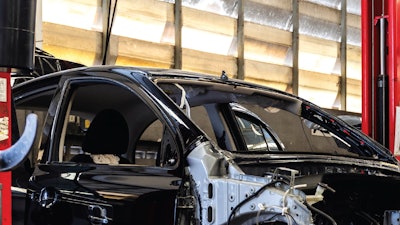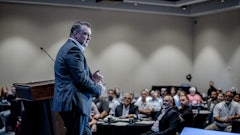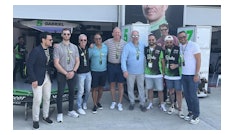
ITS NOT ABOUT THE RIGHT TO REPAIR, IT’S NOW THE NEED TO REPAIR
In the quiet corners of repair bays and the crowded screens of estimators, a silent revolution is waiting to be recognized. It’s the global shift toward repair over replacement—and while sectors like consumer electronics and agriculture are answering the call, the automotive collision industry remains largely on mute.
Th e Right and Need to Repair movement is no longer niche. It’s a full-scale rethinking of how industries interact with their products, their customers, and the planet. From Apple offering self-service repair kits to John Deere conceding to independent agricultural repairs, the message is clear: sustainability, transparency, and customer empowerment are no longer optional—they’re expected. Yet in Canada’s collision repair ecosystem, a culture of default replacement still prevails. Panels, assemblies, and plastic components— many of them perfectly repairable—are routinely discarded. Why? Not because they can’t be fixed, but because the system isn’t built to value the repair.
This isn’t just an operational quirk. It’s an existential issue that affects profitability, sustainability, customer trust, and the longterm relevance of the industry.
WHEN INNOVATION OUTPACES MINDSET
Across industries, repair has evolved from an afterthought to a feature. Apple, once notorious for building impenetrable devices, now touts self-repair as a customer service milestone and environmental commitment. Th rough its Self Service Repair program, it ships tools and parts to consumers along with instructions—an unprecedented move that has reshaped public perception of what premium care looks like.
Similarly, agricultural giants like John Deere, long criticized for locking farmers out of their own machinery, have now opened access to soft ware and parts under public and legal pressure. In both cases, innovation didn’t just change process—it changed narrative. Repair became modern, even cool.
Meanwhile, platforms like iFixit have given the repair economy a digital heartbeat. Their fi x-it guides, repairability scores, and grassroots advocacy have mainstreamed the idea that fixing things is a badge of honour, not a compromise.
So why does the collision repair industry— still default to replacement?
THE REAL COST OF REPLACEMENT
It’s a culture built on legacy logic. Insurers once deemed repairs too unpredictable and supported replace. Technicians often lacked training in the latest materials and methods.
Estimating platforms made replacements easier to write. Over time, replacement became the industry norm—despite parts like headlight assemblies and bumper covers being repairable far more often than current practices reflect. Today, repair-to-replacement ratios for these components remain well below where they should be. But the cost of this status quo is mounting.
• Repair costs are rising as inflation and global supply chains stretch thinner.
• Cycle times are expanding, driven by backordered parts and procedural delays.
• Insurance premiums creep upward, passed down to frustrated consumers.
• And perhaps most strikingly, environmental impact is being overlooked.
The automotive collision industry now ranks as a leading contributor to global polypropylene waste. In Canada alone, thousands of tonnes of perfectly repairable plastic parts are buried in landfills annually. Many of these—like bumper covers, grilles, and headlight housings—could have been salvaged, restored, and reused.
This isn’t a material problem—it’s a mindset problem.
REPAIR IS A COMPETITIVE ADVANTAGE— IF WE LET IT BE
Despite outdated perceptions, modern repair techniques are anything but crude. Emerging companies like Plasnomic, along with global leaders in training like I-CAR Canada and Thatcham Research in UK, are paving the way with science-backed, OEM-compatible methods.
When done right, repair isn’t a downgrade. It’s a craft. It’s a process that requires innovation, precision, and care—especially when working with modern vehicle materials and integrated sensor systems. In fact, a well-executed repair can outperform a replacement in both environmental impact and production time.
Moreover, embracing repair isn’t just smarter— it’s cheaper and greener. It reduces waste, shortens key-to-key time, and keeps value in the shop instead of shipping it to the parts supplier, and its stimulates work for the industry keeping body and paint technicians busy with each repair stimulating hours of work, where a replacement part does very little. So, what’s stopping the shift?

REGULATION IS COMING—READY OR NOT
Around the world, governments are stepping in. The European Union now mandates that manufacturers of electronic devices must provide spare parts and documentation for at least ten years. In the U.S., Right to Repair laws have passed in agriculture and electronics, with automotive legislation gaining steam. Massachusetts has already enforced OEM data sharing with independent repairers—setting a precedent others are watching closely.
Canada won’t be far behind. In fact, some provinces are already studying the implications of repairability legislation as part of broader environmental and consumer protection efforts.
When the collision sector is inevitably pulled into the spotlight, tough questions will follow:
• Why was repair discouraged?
• Why were recyclable parts sent to landfill?
• Why weren’t sustainable, lower-cost alternatives offered to consumers?
If the industry isn’t proactively building a better answer, someone else will.
CULTURE CHANGE STARTS FROM THE BAY FLOOR UP
This isn’t about a single SOP or tool. It’s about reengineering the way we think about our role as repairers. That means:
• Training technicians to treat plastic repair as a specialization—not a shortcut.
• Integrating AI-based validation tools that verify repair quality and compliance.
• Collaborating with insurers to realign KPIs around repair quality, not just cost.
• Educating consumers that a repaired part isn’t a risk—it’s a responsible choice.
• Redesigning workflows and estimates to flag parts for repair before replacement.
Shops that embrace these principles won’t just avoid regulatory risk—they’ll gain strategic edge. Repair becomes a differentiator. A marketing tool. A reason to choose one shop over another.
COLLISION’S DEFINING MOMENT
Collision repair has an opportunity to lead—not follow. But doing so means dismantling the old habits of discard and replace and building a new culture rooted in accountability, craftsmanship, and innovation. If a tech company like Apple can make repair aspirational, why can’t we? If iFixit can spark a global culture shift with digital guides and screwdrivers, imagine what a coordinated industry response could look like.
Let’s stop asking if the part can be replaced. Let’s start asking—if it can be repaired, why isn’t it?




















